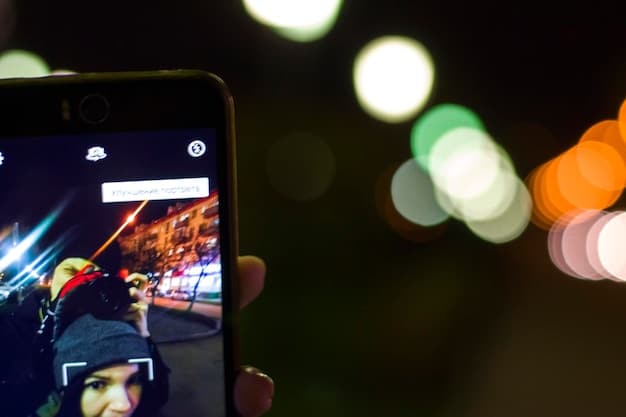Social Media’s Impact on Movie Reviews: Influencers vs. Critics

The Impact of Social Media on Movie Reviews: Are Influencers Replacing Traditional Critics? examines the evolving landscape of film commentary, evaluating how burgeoning social media influence challenges the long-standing authority and methodology of established film critics, leading to a diversified yet fragmented review ecosystem that affects audience perception and box office performance.
In an age where information disseminates at warp speed, the landscape of film critique has undergone a seismic shift, prompting a vital question: The Impact of Social Media on Movie Reviews: Are Influencers Replacing Traditional Critics? This exploration delves into how digital platforms have democratized discourse, challenging the established gatekeepers of cinematic judgment.
The evolving landscape of film critique
The art of film critique has long been the domain of esteemed publications and respected voices, individuals whose opinions shaped public perception and box office fortunes. These traditional critics, often armed with extensive filmographies, theoretical knowledge, and a nuanced understanding of cinematic language, provided a curated guide for audiences navigating the vast world of movies. Their reviews were considered authoritative, a benchmark for quality and artistic merit, published in newspapers, magazines, and broadcast on television and radio. This established ecosystem fostered a sense of stability and credibility within the industry.
However, the advent of the internet and, more significantly, social media platforms, initiated a profound transformation. What began as forums for discussion quickly evolved into powerful publishing tools, accessible to anyone with an internet connection. This democratization of content creation meant that the barrier to entry for expressing opinions on film effectively dissolved. Suddenly, everyone could be a critic, sharing their thoughts, feelings, and immediate reactions to movies with an ever-growing audience. This shift marked the beginning of a new era, where the exclusivity of critique began to wane, making way for a more inclusive, albeit potentially less structured, dialogue.
The rise of citizen critics
The rise of citizen critics, ordinary moviegoers sharing their unvarnished opinions, highlighted a fundamental difference in how film commentary was delivered and received. Unlike traditional critics, these voices often spoke directly from the perspective of the average consumer, unburdened by journalistic conventions or academic frameworks. Their reviews were colloquial, relatable, and frequently driven by emotional responses rather than analytical deconstruction. This authenticity resonated with a wide audience, who felt a stronger connection to these relatable voices than to the often more esoteric pronouncements of professional critics. The sheer volume of these everyday reviews created a new form of collective wisdom, influencing countless viewing decisions.
- Immediate, unfiltered reactions to films.
- Relatable language and personal anecdotes.
- Direct engagement with audience members.
- Focus on viewer experience over technical elements.
From print to pixels: a digital migration
The migration from print to pixels was not merely a change in medium; it was a fundamental shift in the culture of consumption and interaction. Publications that once reigned supreme found themselves scrambling to establish an online presence, adapting to the faster pace and interactive nature of the digital world. This move also amplified the reach of traditional critics, allowing their reviews to be shared and discussed far beyond their original circulation. Yet, this digital transformation also meant they were subject to the same immediate public scrutiny and real-time feedback as any online commenter. The lines between professional and amateur began to blur, forcing a reevaluation of what truly constitutes “expertise” in the digital age.
The digital migration also introduced new metrics of success. While traditional critics measured impact through circulation numbers and critical consensus, online platforms introduced metrics like likes, shares, comments, and follower counts. These new indicators of influence began to compete with, and in some cases overshadow, the long-standing markers of journalistic credibility. This created a competitive environment where both traditional critics and emerging online personalities vied for attention and relevance, each navigating the new rules of engagement in a rapidly evolving media landscape.
Social media’s influence on movie discovery
Social media platforms have profoundly redefined how audiences discover and evaluate movies. No longer solely dependent on trailers, traditional advertising, or critical reviews from established outlets, viewers now encounter film recommendations through a myriad of digital touchpoints. This shift has altered both the speed and the nature of information dissemination, creating a dynamic ecosystem where viral trends and personal endorsements often hold more sway than carefully curated professional opinions. The sheer volume of content shared daily means that a film’s visibility can skyrocket based on a single viral clip, meme, or trending hashtag, even before its official release.
The role of algorithms and echo chambers
Algorithms play an indispensable role in shaping audience perception and discovery. These complex systems analyze user behavior, preferences, and interactions to curate personalized content feeds. While designed to enhance user experience by delivering relevant content, they inadvertently create “echo chambers,” where individuals are primarily exposed to opinions and information that reinforce their existing beliefs. For movie reviews, this means users are more likely to see content from influencers or groups whose tastes align with their own, potentially limiting exposure to diverse perspectives or professionally nuanced critiques. This algorithmic curation amplifies certain voices and perspectives, often favoring those that generate high engagement regardless of their depth or factual accuracy.
- Personalized content feeds based on past interactions.
- Reinforcement of existing biases and preferences.
- Limited exposure to dissenting or analytical viewpoints.
- Amplification of popular or trending opinions over nuanced critiques.
Influencer marketing and paid promotions
The rise of influencer marketing has interwoven commercial interests deeply within the fabric of social media movie reviews. Brands and studios increasingly recognize the immense reach and perceived authenticity of influencers, leveraging their platforms for strategic movie promotion. This often involves paid partnerships where influencers are compensated to create content promoting a film. While these collaborations can generate significant buzz and reach target demographics effectively, they also introduce a layer of commercial bias that can compromise the objectivity of reviews. Transparent disclosure of paid content is crucial for maintaining audience trust, yet the line between genuine recommendation and sponsored content can sometimes blur, challenging the integrity of the review process.
The financial incentives within influencer marketing raise questions about the true independence of these voices. When a significant portion of an influencer’s income derives from brand partnerships, the motivation to produce consistently positive or favorable content can be strong, even tacit. This contrasts sharply with the traditional journalistic ethos, where editorial independence is paramount. Audiences, increasingly savvy, often look for signals that distinguish genuine enthusiasm from contractual obligation, making the authenticity of the influencer’s voice a critical factor in their persuasive power. This intricate dance between promotion and genuine opinion highlights the complex economic realities shaping the modern media landscape.

The traditional critic’s perspective
Traditional film critics have historically served as crucial gatekeepers and navigators within the cinematic world. Their rigorous training, extensive knowledge of film history, theory, and artistic movements, and their commitment to journalistic ethics have long provided a reliable standard for evaluating motion pictures. For decades, their reviews in prestigious publications or broadsheet newspapers were considered definitive, often shaping public discourse and influencing a film’s trajectory, from box office performance to awards consideration. Their authority stemmed not just from their platform but from their cultivated expertise and their ability to contextualize films within broader cultural and artistic narratives.
The depth of analysis versus fleeting reactions
A hallmark of traditional criticism is the emphasis on deep, analytical engagement with a film. Critics often spend considerable time deconstructing narrative structures, directorial choices, thematic undercurrents, and performances, offering nuanced perspectives that go beyond surface-level reactions. This comprehensive approach aims to illuminate a film’s artistic merits and deficiencies, providing readers with insights that enhance their understanding and appreciation. These reviews generally adopt a structured format, employing sophisticated language and drawing upon a rich vocabulary of cinematic terms. They are designed to stand the test of time, offering enduring commentary rather than immediate, transient feedback.
Conversely, much of social media commentary thrives on immediacy and brevity. Reactions often manifest as quick likes, brief comments, or short video snippets, capturing immediate emotional responses rather than thorough critical examination. This isn’t inherently negative; it speaks to a different form of engagement, one that prioritizes speed and accessibility. However, this immediacy frequently comes at the expense of depth, making it challenging for such content to offer anything beyond a superficial assessment. The contrast highlights a fundamental divergence in purpose: traditional critics aim to build an informed understanding, while social media responses often aim for instant connection and broad relatability.
- Traditional critics: Focus on contextual analysis, historical placement, and artistic intent.
- Social media: Prioritizes immediate emotional impact and peer-to-peer discussion.
- Differences in format: Long-form essays versus short-form posts or videos.
- Impact on audience: Educating versus entertaining and quick recommendations.
Maintaining journalistic integrity and ethical standards
The ethical framework underpinning traditional journalism, including film criticism, mandates objectivity, fairness, and transparency. Critics are expected to avoid conflicts of interest, disclose any potential biases, and base their evaluations on the merits of the film itself, rather than external pressures or personal relationships. This commitment to journalistic integrity builds public trust and ensures that reviews are perceived as independent and credible. Publications often have strict editorial guidelines, including fact-checking processes and detailed review policies, to uphold these standards. This structured environment is designed to safeguard the impartiality of the critique.
However, the rise of influencer culture presents new challenges to these ethical paradigms. The commercialization of online spaces means that many influencers operate within less regulated environments, where the lines between content creation and advertising can become deliberately blurred. While some adhere to strict disclosure rules (often mandated by regulatory bodies like the FTC), others may not, leading to situations where promotional content is disguised as genuine, unbiased opinion. This lack of consistent ethical oversight can erode public trust in online reviews and makes it more difficult for audiences to discern authentic recommendations from marketing ploys. It underscores the ongoing tension between traditional journalistic values and the commercial realities of the digital influencer economy.
The influencer phenomenon: reach and relatability
The influencer phenomenon has fundamentally reshaped consumer behavior, particularly in areas like entertainment. Their appeal lies predominantly in two key attributes: unparalleled reach and profound relatability. Unlike traditional celebrity endorsements, which can feel anachronistic or overtly commercial, influencers often cultivate a persona that is accessible, authentic, and akin to a trusted friend. This perceived authenticity allows them to build deeply engaged communities that trust their recommendations, whether these are for products, services, or, increasingly, films. Their content often feels organic and unscripted, fostering a connection that transcends mere viewership.
Building communities and driving engagement
Influencers excel at building and nurturing highly engaged communities around shared interests. For movie influencers, this means cultivating a loyal following of cinephiles who look to them for recommendations, discussions, and often, a sense of belonging. The interactive nature of social media platforms enables direct engagement through comments, Q&A sessions, live streams, and polls, creating a two-way dialogue that traditional media outlets struggle to replicate. This immediate and personal interaction fosters a strong sense of loyalty and identification among followers, transforming passive viewers into active participants. The dynamic relationship enables influencers to quickly mobilize their audience, driving trends and sparking widespread conversations about films.
The sheer volume of engagement generated by influencers translates into a powerful marketing tool. When an influencer recommends a film, their followers are not just passively receiving information; they are often prompted to act, whether by watching a trailer, seeking out the film, or engaging in discussions themselves. This active participation creates a ripple effect, multiplying the reach of the original recommendation far beyond the influencer’s immediate follower count. The cumulative effect of these individual actions can significantly impact a film’s visibility and initial box office performance, proving that engagement metrics can sometimes be as crucial as traditional viewership numbers.
The speed and accessibility of influencer reviews
One of the most compelling advantages of influencer reviews is their unparalleled speed and accessibility. Unlike traditional critics who adhere to publishing schedules and often embargoed release dates, influencers can post their reactions almost instantaneously. This real-time commentary is particularly appealing in a fast-paced digital world where audiences crave immediate information and opinions. A film can be reviewed minutes after a screening, allowing for an immediate buzz or pushback to materialize online. This rapid dissemination of opinion can be a double-edged sword, however, as it often prioritizes speed over detailed analysis or deep reflection.
Furthermore, influencer reviews are incredibly accessible. They are found on platforms that users natively scroll through multiple times a day, seamlessly integrated into their daily digital consumption habits. This contrasts with seeking out a specific newspaper or website for a traditional review. The varied formats—short videos, Instagram stories, TikToks, tweets—cater to diverse preferences, making content consumable in bite-sized, easily digestible pieces. This ease of access and consumption lowers the barrier for engagement, making influencers a readily available source of cinematic opinion for millions globally. Their ability to deliver quick, relatable content directly to their audience’s feeds ensures their continued relevance in the fast-paced world of entertainment commentary.
Impact on film consumption and box office
The evolving landscape of film reviews, influenced heavily by social media and the rise of influencers, has undeniably altered patterns of film consumption and, consequently, box office performance. While traditional metrics like critical acclaim still hold weight, the collective sentiments expressed across digital platforms, particularly by influential online personalities, exert a significant pull on audience decisions. This complex interplay of forces creates a less predictable environment for studios and distributors, where viral momentum can sometimes outpace traditional marketing efforts, and negative social media sentiment can swiftly derail a film’s prospects.
Audience trust and decision-making
Trust is the currency of influence, and in the digital age, audiences often place a higher degree of trust in voices that feel authentic and relatable, rather than explicitly authoritative. Social media influencers, through their perceived transparency and direct engagement with followers, often cultivate this sense of trust more effectively than established critics operating behind institutional facades. When deciding whether to watch a film, particularly during its crucial opening weekend, many viewers now consult multiple sources: snippets from trailers, reactions from friends on social media, and importantly, the opinions of their favorite influencers. This multi-source consultation dilutes the singular authority once held by traditional critics.
- Audiences value relatability and perceived authenticity over institutional authority.
- Decision-making involves cross-referencing multiple social media sources.
- Peer recommendations and influencer endorsements influence choices heavily.
- Traditional critical reviews are still consulted but are no longer the sole determinant.
From critical consensus to social buzz
The shift from a critical consensus model to one driven by social buzz represents a profound transformation in how a film’s success is defined and anticipated. Historically, a strong aggregate score from esteemed critics (e.g., Rotten Tomatoes’ “Certified Fresh” status) was a powerful indicator of quality and a strong predictor of box office success. While these scores remain relevant, the immediate and widespread “buzz” generated on social media now often dictates a film’s initial market performance. A film can accumulate millions of views on TikTok for a single scene, or spark intense debate on Twitter, generating a level of public awareness and urgency that traditional reviews might not achieve at the same speed.
This phenomenon means that studios increasingly prioritize cultivating early social media buzz, often inviting influencers to exclusive screenings and creating early access content specifically designed for viral sharing. The goal is to generate positive momentum before opening weekend, creating a sense of “must-see” urgency. Conversely, negative social media buzz can be incredibly damaging, spreading rapidly and discouraging potential viewers. Even if traditional critics later offer nuanced or positive reviews, the initial social media narrative can be difficult to counteract. This highlights a new dynamic where immediate public opinion, amplified by social media, can disproportionately impact a film’s short-term commercial viability, sometimes overshadowing its long-term critical reception.
The evolving role of the critic
As the media landscape continues its rapid evolution, the role of the film critic is not diminishing, but rather transforming. While the traditional gatekeeper function may be less absolute than before, the need for informed, articulate, and trustworthy voices remains paramount. Critics are no longer the sole arbiters of taste, but their capacity for deep analysis, historical context, and ethical commentary provides a crucial counter-balance to the sometimes superficial or commercially driven discourse of social media. Their influence is shifting from dictating opinion to guiding interpretation and fostering deeper engagement with cinema.
Adapting to digital platforms: new formats and engagement
To remain relevant, traditional critics and journalistic outlets are actively adapting to digital platforms, leveraging new formats and engagement strategies. This involves more than simply reposting print reviews online; it means embracing video essays, podcasts, live Q&A sessions, and interactive content that resonates with a digitally native audience. Many critics are developing their own personal brands on platforms like YouTube, X (formerly Twitter), and Instagram, directly engaging with followers and offering supplementary content that complements their written work. This expanded presence allows them to reach younger demographics and maintain a fresh, accessible voice.
Furthermore, critical outlets are experimenting with shorter, more immediate forms of commentary that align with social media consumption habits, while still maintaining their core values of depth and integrity. This might involve quick takes on new releases, curated lists of recommendations, or brief analyses of film trends, all designed to capture attention and direct audiences back to more comprehensive reviews. The challenge lies in balancing the need for speed and accessibility with the commitment to rigorous analysis, ensuring that quality is not sacrificed for viral appeal. This strategic adaptation is essential for critics to sustain their influence in an increasingly fragmented media environment.
- Adoption of video, podcast, and live streaming formats.
- Direct engagement with audiences through comments and Q&A.
- Creation of supplementary content for social media platforms.
- Experimentation with shorter, more digestible forms of critique.
Collaboration, curation, and the future of reviews
The future of film reviews likely involves a greater emphasis on collaboration and curation. Instead of a zero-sum game between critics and influencers, there’s potential for symbiotic relationships. Traditional critics can lend their expertise to broader discussions, providing factual context and historical perspective that may be lacking in rapid-fire social media commentary. Influencers, in turn, can serve as powerful conduits for disseminating critical insights to wider, more diverse audiences, amplifying the reach of nuanced discussions. This collaborative model could enrich the overall cinematic discourse, offering audiences both immediate reactions and thoughtful analysis.
Moreover, the role of curation will become increasingly vital. In an era of informational overload, audiences need trusted guides to navigate the deluge of content. Critics and reputable media outlets can specialize in curating quality content, distinguishing genuine insight from superficial opinion, and highlighting emerging voices that contribute meaningfully to the conversation. This involves not just reviewing films but reviewing the reviews themselves, providing context on who is saying what and why it matters. By embracing these evolving roles—as educators, collaborators, and curators—critics can solidify their enduring value, ensuring that deep, informed commentary remains a cornerstone of the film industry’s vibrant ecosystem.
Navigating the fragmented review ecosystem
The current landscape of movie reviews is best described as fragmented, a mosaic of diverse voices, platforms, and methodologies, each vying for audience attention. Unlike the more unified system of past decades, where a few major publications held sway, today’s ecosystem is characterized by decentralization. Audiences now navigate a complex web of traditional journalistic reviews, aggregate scoring sites, social media feeds brimming with influencer opinions, and peer-to-peer recommendations. This fragmentation offers both rich diversity and inherent challenges, requiring audiences to become more discerning consumers of information and content.
The challenge of discerning quality and bias
One of the most significant challenges within this fragmented ecosystem is discerning review quality and identifying potential biases. While traditional critics operate under established ethical guidelines and institutional oversight, many social media influencers do not. The line between genuine enthusiasm and paid promotion can be perilously thin, and without clear disclosure, audiences may unknowingly consume marketing disguised as organic opinion. Furthermore, the sheer volume of amateur reviews makes it difficult to distinguish between well-reasoned critiques and those based on fleeting emotions or even deliberate trolling. This demands a higher degree of media literacy from the audience.
- Difficulty in distinguishing paid promotions from genuine opinions.
- Varied standards of critical rigor among online commentators.
- Need for enhanced media literacy among consumers.
- Risk of encountering emotionally charged or unverified reviews.
The future of film review and audience engagement
The future of film review and audience engagement will likely involve a dynamic interplay between different forms of commentary, rather than one replacing the other. Traditional critics will continue to provide depth, context, and a benchmark for artistic evaluation, appealing to audiences who value considered analysis. Social media influencers will remain crucial for immediate buzz, relatability, and driving mass engagement, particularly among younger demographics. Aggregate sites will continue to offer a quick snapshot of overall sentiment, synthesizing opinions from diverse sources. The most successful films will probably be those that manage to resonate across all these varied channels, generating both critical acclaim and widespread popular appeal.
Ultimately, the future ecosystem suggests a more personalized and interactive experience for the audience. Viewers will curate their own trusted sources, blending insights from critics, influencers, and peers based on their individual preferences and viewing habits. The emphasis will shift from a singular authoritative voice to a chorus of diverse opinions, where individual viewers piece together their own informed perspective. This evolution necessitates a continuing adaptation from content creators and platforms alike, ensuring that the dialogue around film remains vibrant, intelligent, and widely accessible for generations to come.
| Key Aspect | Brief Description |
|---|---|
| 📊 Traditional Critics | Offer deep analytical reviews, adhering to journalistic ethics and often shaping long-term critical consensus. |
| 📱 Social Media Influencers | Provide immediate, relatable reviews, building strong communities and driving quick buzz on films. |
| 🔄 Evolving Impact | Social media impacts immediate box office; traditional reviews influence long-term perception and awards. |
| 🤝 Future Landscape | A complementary ecosystem where critics provide depth, influencers drive buzz, and audiences curate their own trusted sources. |
Frequently asked questions
▼
No, influencers are not fully replacing traditional critics. Instead, they are broadening the landscape of film commentary. While influencers offer immediate, relatable reactions and drive significant buzz, traditional critics continue to provide in-depth analysis, historical context, and adhere to journalistic ethical standards. Both play distinct, complementary roles in how films are reviewed and perceived by audiences today.
▼
Social media algorithms personalize content feeds, often leading to echo chambers where users primarily see reviews and opinions aligning with their existing tastes. This can amplify certain viral trends and influencer voices, impacting discovery and potentially limiting exposure to diverse, analytical perspectives, including those from traditional critics. Algorithms thus shape what reviews are seen and how public perception is formed.
▼
Ethical challenges include transparency regarding paid promotions and potential conflicts of interest. Unlike traditional journalism, which has established ethical guidelines, the commercialization of influencer content can blur the line between genuine recommendation and sponsored content. Audiences must discern if a review is an unbiased opinion or a marketing play, making disclosure of partnerships crucial for maintaining trust.
▼
The impact on box office performance has shifted from being solely driven by critical consensus to being heavily influenced by social buzz. Positive social media momentum and viral trends can significantly boost a film’s opening weekend. Conversely, negative social media sentiment can swiftly deter audiences. While critical reviews still matter for long-term perception, immediate social media chatter often dictates short-term commercial success.
▼
Traditional critics are adapting by leveraging digital platforms, adopting new formats like video essays and podcasts, and engaging directly with audiences. Their evolving role is to provide essential historical context, deep analytical insights, and ethical commentary that complements the immediate nature of social media reviews. They act as curators, guiding audiences through the fragmented information landscape while maintaining standards of credibility and depth.
Conclusion
The evolving landscape of film critique demonstrates a dynamic interplay rather than a simple replacement. While social media influencers have undeniably carved out a significant space, leveraging their vast reach and relatability to spark immediate buzz and influence audience decisions, traditional critics continue to offer indispensable depth, analytical rigor, and a commitment to journalistic integrity. The future of film reviews lies not in the triumph of one over the other, but in a symbiotic relationship where different voices cater to diverse needs, ultimately enriching the overall cinematic discourse and offering audiences a more comprehensive, albeit fragmented, lens through which to view and engage with movies.





